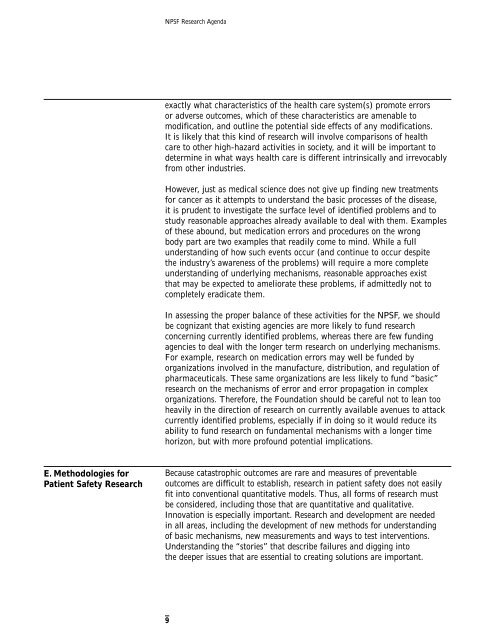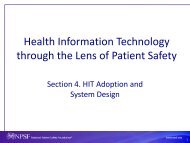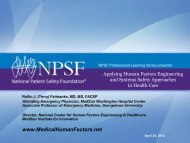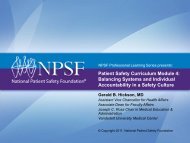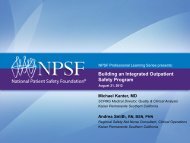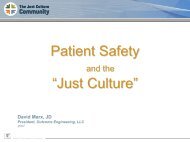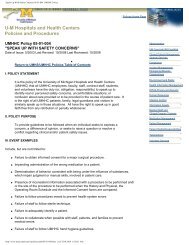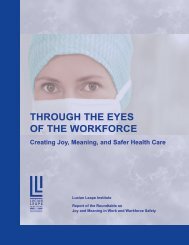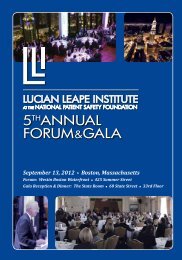Agenda for Research and Development in Patient Safety
Agenda for Research and Development in Patient Safety
Agenda for Research and Development in Patient Safety
- No tags were found...
Create successful ePaper yourself
Turn your PDF publications into a flip-book with our unique Google optimized e-Paper software.
NPSF <strong>Research</strong> <strong>Agenda</strong>exactly what characteristics of the health care system(s) promote errorsor adverse outcomes, which of these characteristics are amenable tomodification, <strong>and</strong> outl<strong>in</strong>e the potential side effects of any modifications.It is likely that this k<strong>in</strong>d of research will <strong>in</strong>volve comparisons of healthcare to other high-hazard activities <strong>in</strong> society, <strong>and</strong> it will be important todeterm<strong>in</strong>e <strong>in</strong> what ways health care is different <strong>in</strong>tr<strong>in</strong>sically <strong>and</strong> irrevocablyfrom other <strong>in</strong>dustries.However, just as medical science does not give up f<strong>in</strong>d<strong>in</strong>g new treatments<strong>for</strong> cancer as it attempts to underst<strong>and</strong> the basic processes of the disease,it is prudent to <strong>in</strong>vestigate the surface level of identified problems <strong>and</strong> tostudy reasonable approaches already available to deal with them. Examplesof these abound, but medication errors <strong>and</strong> procedures on the wrongbody part are two examples that readily come to m<strong>in</strong>d. While a fullunderst<strong>and</strong><strong>in</strong>g of how such events occur (<strong>and</strong> cont<strong>in</strong>ue to occur despitethe <strong>in</strong>dustry’s awareness of the problems) will require a more completeunderst<strong>and</strong><strong>in</strong>g of underly<strong>in</strong>g mechanisms, reasonable approaches existthat may be expected to ameliorate these problems, if admittedly not tocompletely eradicate them.In assess<strong>in</strong>g the proper balance of these activities <strong>for</strong> the NPSF, we shouldbe cognizant that exist<strong>in</strong>g agencies are more likely to fund researchconcern<strong>in</strong>g currently identified problems, whereas there are few fund<strong>in</strong>gagencies to deal with the longer term research on underly<strong>in</strong>g mechanisms.For example, research on medication errors may well be funded byorganizations <strong>in</strong>volved <strong>in</strong> the manufacture, distribution, <strong>and</strong> regulation ofpharmaceuticals. These same organizations are less likely to fund “basic”research on the mechanisms of error <strong>and</strong> error propagation <strong>in</strong> complexorganizations. There<strong>for</strong>e, the Foundation should be careful not to lean tooheavily <strong>in</strong> the direction of research on currently available avenues to attackcurrently identified problems, especially if <strong>in</strong> do<strong>in</strong>g so it would reduce itsability to fund research on fundamental mechanisms with a longer timehorizon, but with more profound potential implications.E. Methodologies <strong>for</strong><strong>Patient</strong> <strong>Safety</strong> <strong>Research</strong>Because catastrophic outcomes are rare <strong>and</strong> measures of preventableoutcomes are difficult to establish, research <strong>in</strong> patient safety does not easilyfit <strong>in</strong>to conventional quantitative models. Thus, all <strong>for</strong>ms of research mustbe considered, <strong>in</strong>clud<strong>in</strong>g those that are quantitative <strong>and</strong> qualitative.Innovation is especially important. <strong>Research</strong> <strong>and</strong> development are needed<strong>in</strong> all areas, <strong>in</strong>clud<strong>in</strong>g the development of new methods <strong>for</strong> underst<strong>and</strong><strong>in</strong>gof basic mechanisms, new measurements <strong>and</strong> ways to test <strong>in</strong>terventions.Underst<strong>and</strong><strong>in</strong>g the “stories” that describe failures <strong>and</strong> digg<strong>in</strong>g <strong>in</strong>tothe deeper issues that are essential to creat<strong>in</strong>g solutions are important.9


